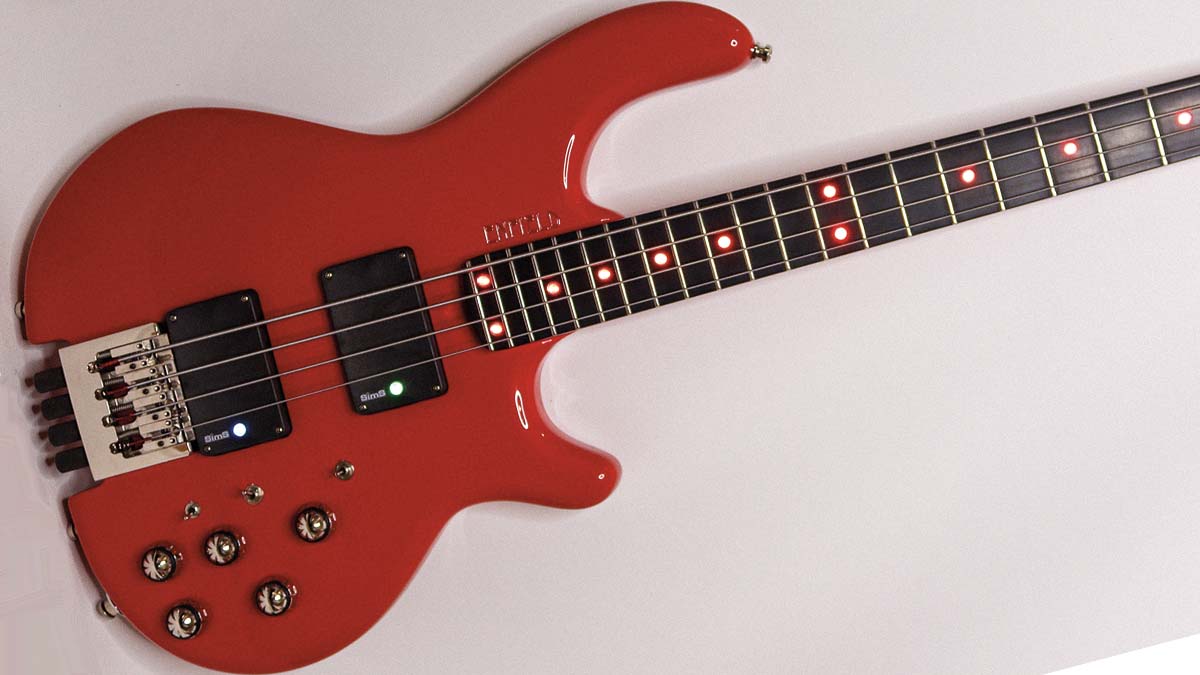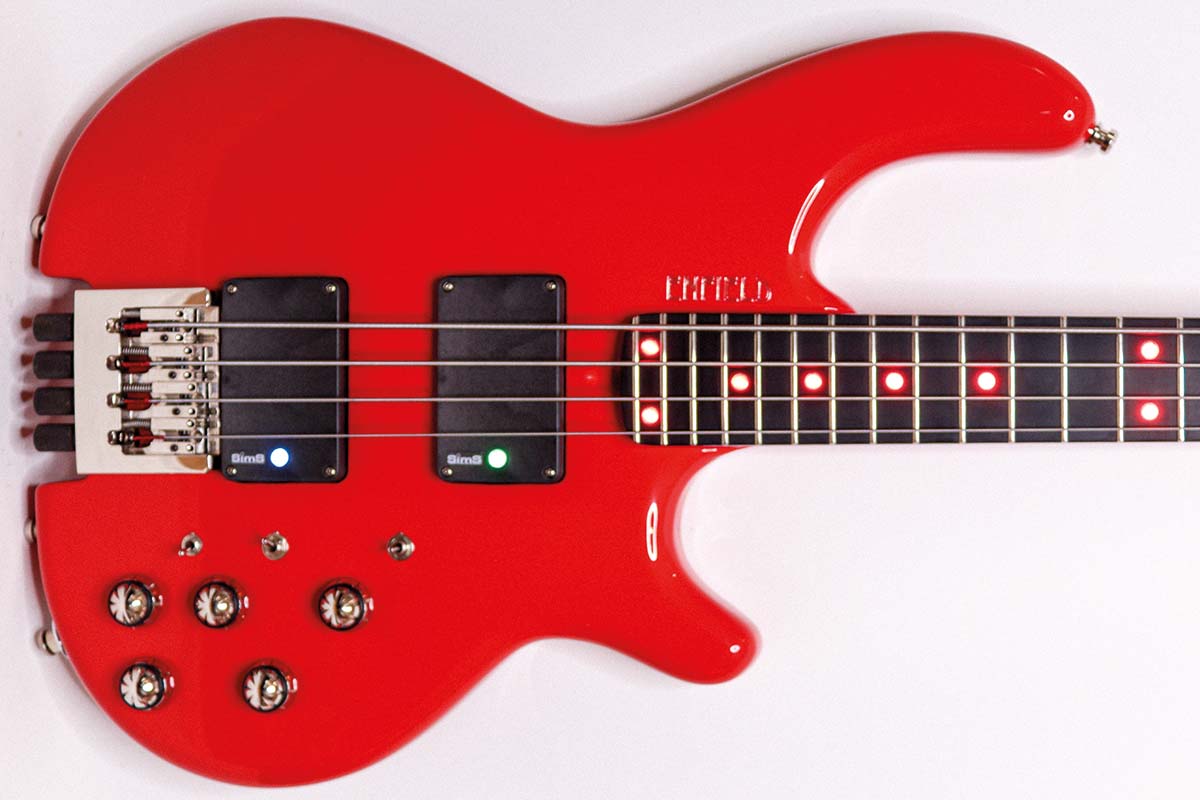Guitar World Verdict
A superb, state-of-the-art bass for the professional.
Pros
- +
Very playable.
- +
Huge tone palette.
Cons
- -
Do you actually need all those tones?
You can trust Guitar World
Sims Guitars, makers of Enfield bass guitars, hit gold a few years back with their versatile Super Quad pickups, which enable the user to emulate Precision, Jazz, and humbucker tones at the flick of a three-position microswitch.
With this new headless bass, the Antoinette, two of these futuristic units are installed alongside a whole range of features, many standard, but some as custom extras, so investigate the options with Sims if you’re thinking of investing.
Talking of investment, the pricetag is hefty, but not unreasonably so given the quality and spec of the bass: Whether you’ll require all the tonal tools is another question entirely. Let’s plug and play.
Build Quality
From the hand-painted gold rose on the back of the Antoinette’s sort-of-headstock, down to the magnetic rear-body cavity cover, we had no issues with the quality of assembly or design.
The London Red finish, with a custom matching finish to the neck, is flawless, as it should be at this price point. It’s subjective, of course, but we like the gold and red combination, and the body shape is sleek and elegant; what’s far from subjective is the impressive weight of the bridge and incorporated tuners, the satisfyingly immovable pickup fittings, and the very slick two-octave phenolic fretboard.

The active EQ controls dominate the body, with those silver globe control designs giving the bass a slightly sci-fi edge; three microswitches – two for the Super Quads and one for the LEDs at front and edge of the neck – are positioned so they don’t get in the way.
There’s a side-mounted ‘speed jack socket’, which earns its name with its useful location and quick operation, and a double action truss rod, accessible at the neck heel. All in all, it’s obvious where your taxed income is being spent: On quality and attention to detail.
Sounds and Playability
This bass seems designed to point you at its tone options, the core of its appeal: As you may have figured out, two three-mode pickups plus a three-band boost is a combination that gives you a whole lot of tone-refining possibilities.
As our reviewer Stuart Clayton pointed out when we first reviewed the Super Quads, the red (P-Bass), blue (J-Bass) and green (humbucker) LEDs that light up when you select a mode soon have you thinking of each tone as a color, which is weird but definitely interesting – almost like a form of applied synaesthesia.
For this test, I assumed the red mode to be the default, as Precision tones are so familiar. The thuddy chunk of that old reliable sound is there under your fingers, and can be modulated with the bass, mids and treble boost/cut of the Glockenklang preamp – fitted here as an extra – as you choose.

The low-end boost is manageable rather than monstrous, which is a relief, and the mids and top restrained in this mode. Switch to blue or green modes for rather more clank and twang, which is useful should you decide to slap or tap; the blue setting is the place to go for a touch of hollow throatiness, if you need to cut through your band live.
Combine the modes – with green at the bridge and blue at the neck – and you then have even more options at your disposal. Refine your chosen tone with the EQ, and you’ll probably find your ideal sound sooner rather than later.
The question is, of course, whether you need all these tone options in your current gig. Regardless of the tone wizardry under the hood, the Antoinette plays like a dream.
The short-scale phenolic fretboard has a bounce and smooth solidity that rewards all levels of playing intensity, and the bass feels at home whether you pluck gently for some quiet subtlety, or apply enthusiastic pick downstrokes in the name of volume. Of course, its looks are pure funk, but don’t let that put you off deploying it for other uses.
Conclusion
Other headed and headless basses exist at this end of the market with similar design and engineering levels, of course, but the Sims pickup system delivers options that are rarely seen elsewhere.
If tone-tweaking is your passion, and you would rather make those refinements on board than via an external EQ of some kind – and, of course, the budget is there – you should definitely investigate.
Specs
- PRICE: $3195 (review model includes some custom specs)
- MADE IN: UK
- BODY: East Asian mahogany
- NECK: Five-piece laminate with premium North American quarter-sawn hard rock maple and phenolic stringers, 32” scale
- NECK JOIN: Bolt-on, five bolts
- FRETBOARD: Phenolic, 16.5mm string spacing, 24 jumbo frets
- PICKUPS: 2 x Sims Super Quads
- ELECTRONICS: Three-band non-stacked Glockenklang preamp
- CONTROLS: Three-band EQ, volume, tone, 2 x Super Quad microswitches, LEDs on/off
- HARDWARE: Nickel and black, Hipshot headless system
- WEIGHT: 7.3 lbs
- GIGBAG/CASE INCLUDED: Hiscox flight case
- LEFTIE AVAILABLE: As custom option
- CONTACT: Sims Bass Shop
Joel McIver was the Editor of Bass Player magazine from 2018 to 2022, having spent six years before that editing Bass Guitar magazine. A journalist with 25 years' experience in the music field, he's also the author of 35 books, a couple of bestsellers among them. He regularly appears on podcasts, radio and TV.
“Affordable versions of the three best basses I've ever held in my hands”: Sterling by Music Man completes its trilogy of Joe Dart signature models with a trio of made-to-order basses that cost less than $500
“The ace up the sleeve of bass players around the globe since 1978”: Tobias instruments were trailblazers in the bass world. Now they’re back as part of the Gibson family












